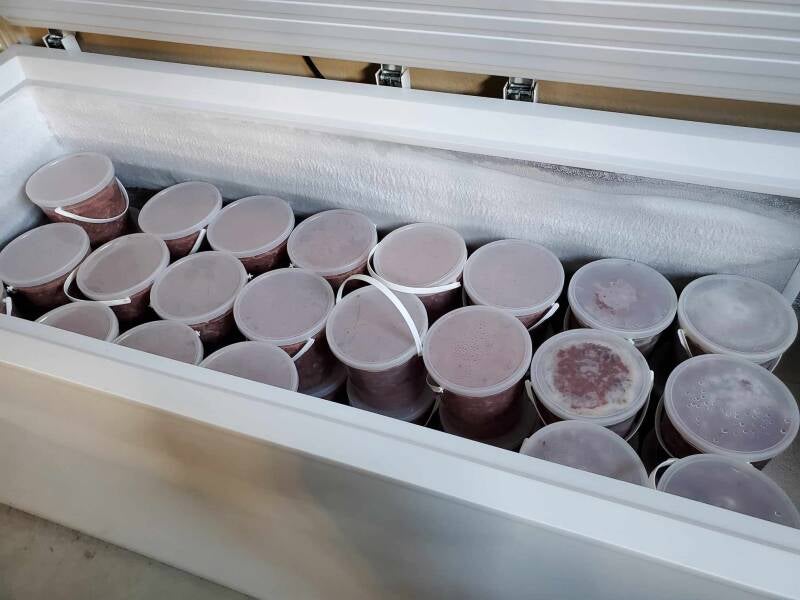Feeding Raw

We used to feed Science Diet dry to our cats and then switched to Royal Canin. We then tried a few others and always with same results... we had too many with diarrhea problems and just not thriving. We spent a small fortune on vets and prescription foods but then learned what the dry food market is actually about. A breeder friend in Canada, Judith Schulz, talked me into trying to feed raw and I have never regretted it. We have fed raw meat since then and dry is used for a couple boys who came to us used to only dry but they also eat raw meat mix.
Cats are carnivores and need meat. Too many of the dry foods that are out there nowadays, are full of fillers and ingredients that are dangerous to the long-term health of your cat. It is just like with people....if they do not eat right, they may be okay, but they may not. And if you love your cat, why take a chance on their future? For those who prefer to buy grocery store meats, there is a company who sells a powder mix for that. Feline Instincts, in Florida, has a few varieties of powder to fit your needs. They also sell a powdered liver (beef or chicken) and a large squeeze bottle of salmon oil (saves pricking oil capsules for each meal). Our cats have done well on this and love the flavor. Our kittens were raised on this mix and really thrived on it. You can buy this powder with the liver included, as we did, saving yourself time. UPDATE:
We have recently changed our raw meat we feed our cats. The frozen ground turkey we were buying suddenly had very high content and was really soupy and awful and when mixed up the cats refused to eat. For weeks I tried everything and finally we bought a grinder. If you get online and google a group called BARF (bones are real food) they recommend a LEM grinder that grinds chicken bones w/meat. So, we purchased the biggest one they had, and it has been a true blessing. We now buy chicken leg quarters at the store and pull the skin off. Then they go into the grinder. Now this is not enough for the felines to eat, so we also buy cases of chicken heart (for taurine) and chicken liver (measure this one out as too much is not good). A couple times a month we then grind the heart and liver, then get all the chicken ready and grind that. Then in my mixer, we measure out the meat mix, the liver mix, the heart mix and add some liquid (usually blood that is in the bags of all these parts and then add salmon oil and raw egg yolks, sometimes some benebac, and sometimes added powdered taurine). Once mixed up we measure everything into our plastic buckets and put in freezer. When frozen, these buckets are 5 pounds. We are presently feeding 2.5 pounds a day, up to 3 buckets a day. Lots of meat but wow do they love this. Sometimes we have extra heart and that is ok, as the cats can eat that by itself on occasion without any problems (like liver would be a problem)
Below are some photos from our mixing....
------------------------------------------------------------------------------------------------------------------------------------------------------------------------------------------------
For this book shown at top of page....copy/paste ....
Pet Food is the only food industry allowed to lie to consumers. The only food industry given FDA permission to violate federal food safety law. Buyer Beware is the documented truth about what millions of pet parents are unknowingly feeding their pets. "While pet food advertising bombards us with the images of plump fresh meats, brightly colored vegetables, and beautiful grains in their products, Susan talks about ethoxyquin, recalls, rendering, and deceptive advertising. And she’s got the facts to back up her writings. Something, as you will learn from reading this book, the pet food industry is not required to have. It is high time that the pet food industry’s secrets were brought to light. This book represents a giant step toward exposing everyday practices that jeopardize our pets’ health. Learn the truth." Laurie S. Coger, DVM, CVCP www.TheWholisticVet.com Buyer Beware includes a large section explaining the regulations within the pet food industry, including shocking details of little-known FDA Compliance Policies that allow diseased animals, pesticide contaminated food ingredients, and much more, to be processed into pet food. Further, the new book contains a section titled 'How Horrible Can Pet Food Ingredients Get? providing readers easy to understand details of common pet food ingredients such as Animal Fat, By-Product Meal, Canola Oil, Dyes, and much more. The book also includes eight personal stories of pet food tragedy: some tragedies of the 2007 pet food recall and other tragedies from 'regular' non-recalled pet food. "As I was reading the pet tales to Mom, we both started bawling. Those stories are just heart breakers" says Mollie M. pet parent that previewed Buyer Beware. Mollie M. also shared "This is exactly what I have been searching for, a book on the truth behind the pet food industry. There is not a single book on the market today like this; I know, I have been searching for one." Buyer Beware represents years of research and writing from TruthaboutPetFood.com; learn the truth about what your dog or cat could be eating.
Our monthly meat grinding is shown in many photos below. Contact us if you have any questions.... kumskaka@hotmail.com


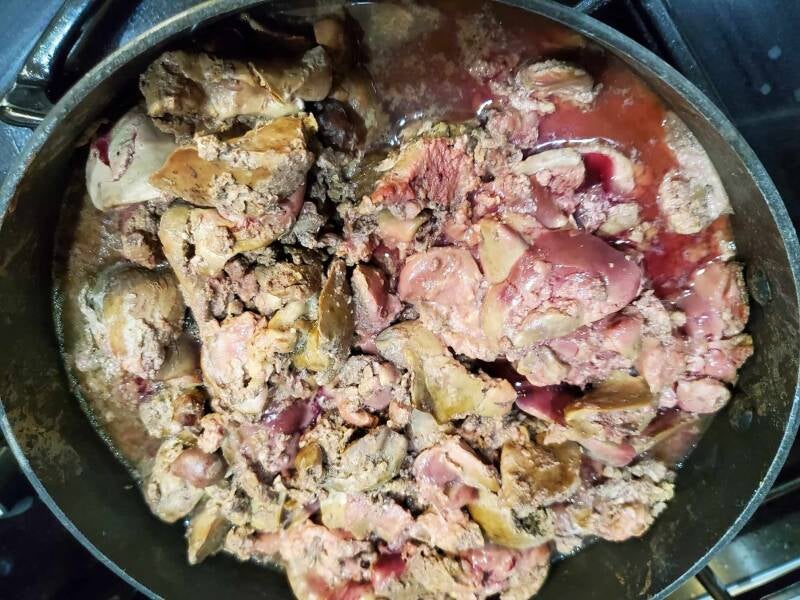
Above left is ground chicken hearts, above right is chicken livers, being partially cooked since my cats hate raw liver
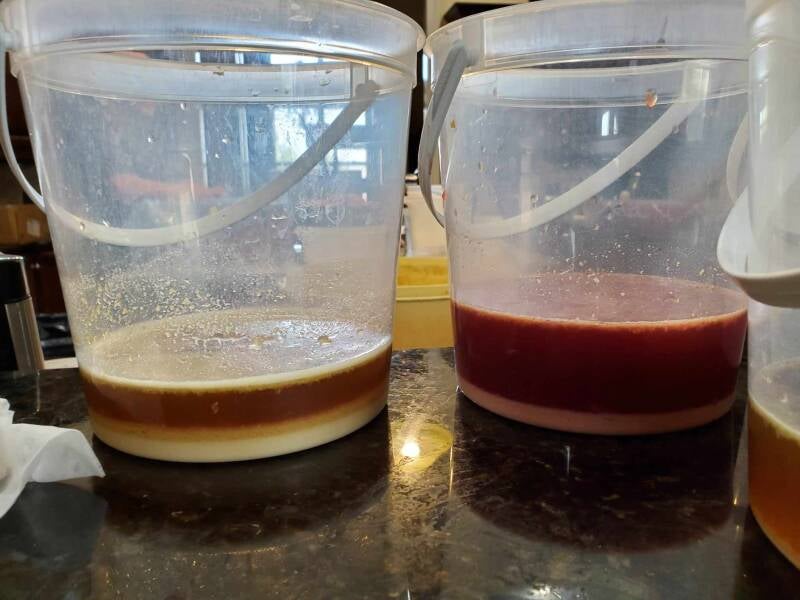
We cook and save all broth and freeze it to use with our mixing. Sometimes we have to buy some. Then I will mix the Nutrional Yeast (Vit B), Taurine and Lysine (when we add it), with broth. Sometimes beef, sometimes chicken. The buckets to the left show the mix. Just before each batch being mixed together, I stir the broth and vitamins together. My cats like the raw meat mix to be a thinner mix so we add warm water at times also.

My 12 year old Granddaughter, Kambrie, came and stayed a couple weeks with us recently. We had a day of meat grinding and we got her up early morning to help with each step. Some of her expressions show how much she enjoyed this. It was extra fun watching her though.
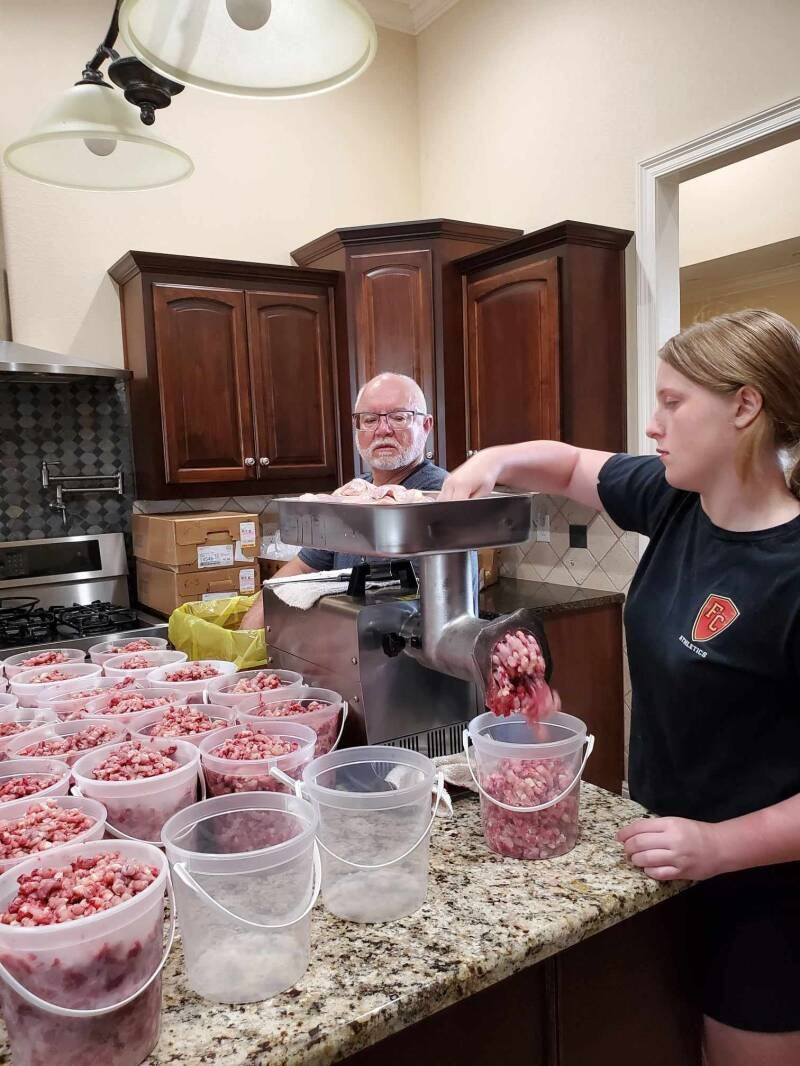
Step 1: grind the chicken hearts. Fill the buckets and move aside. Step 2: Grind the chicken thighs, without the skins.
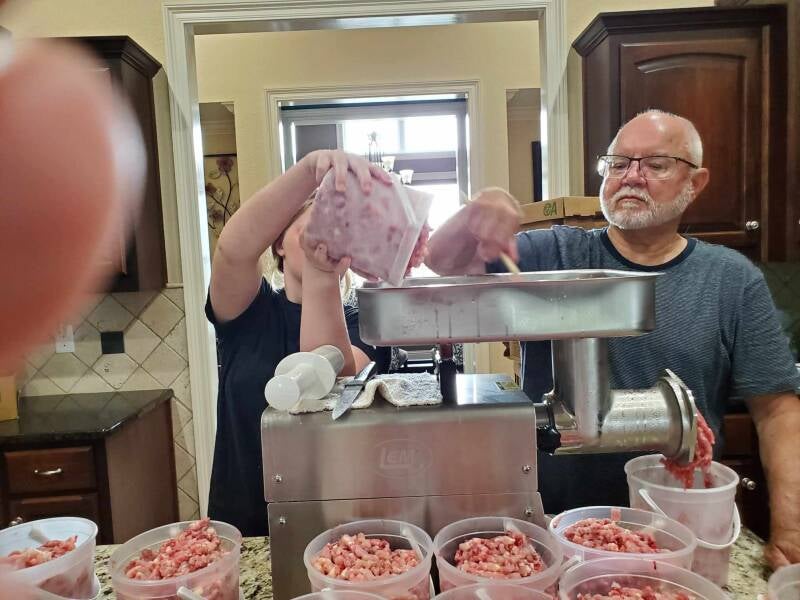
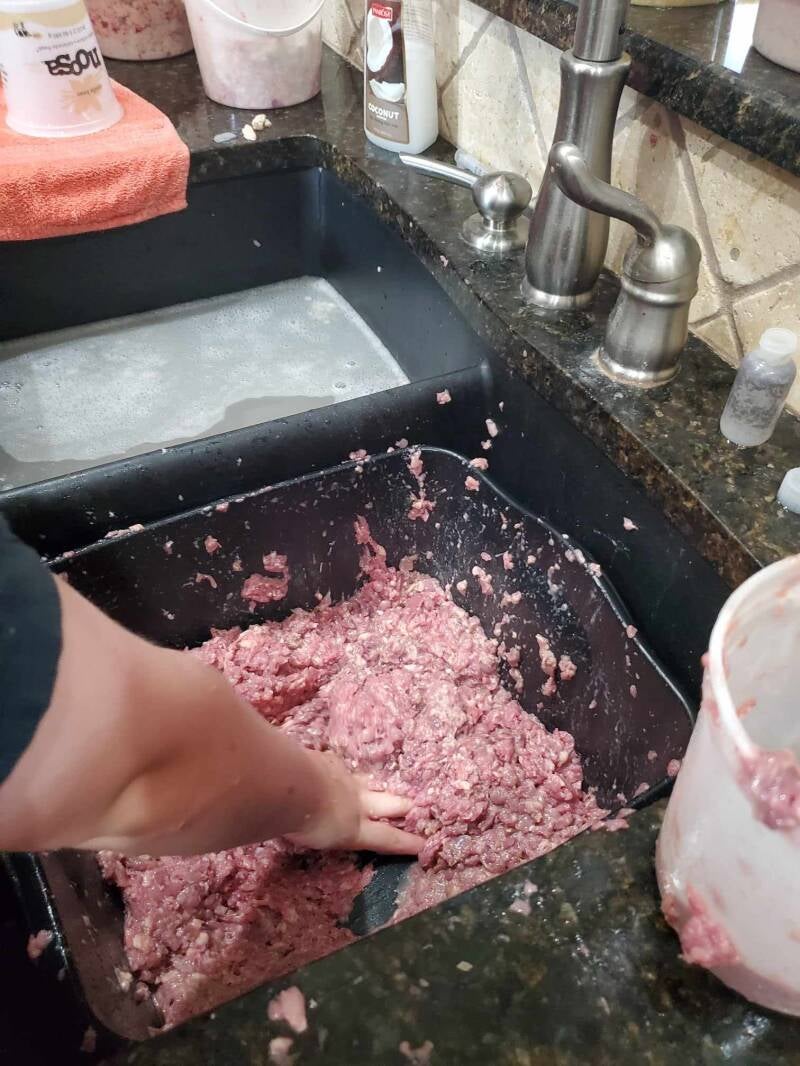
Step 3: do a 2nd grind on the chicken and it comes out really soft Step 4: measure meat, liver (cooked), heart and vitamins
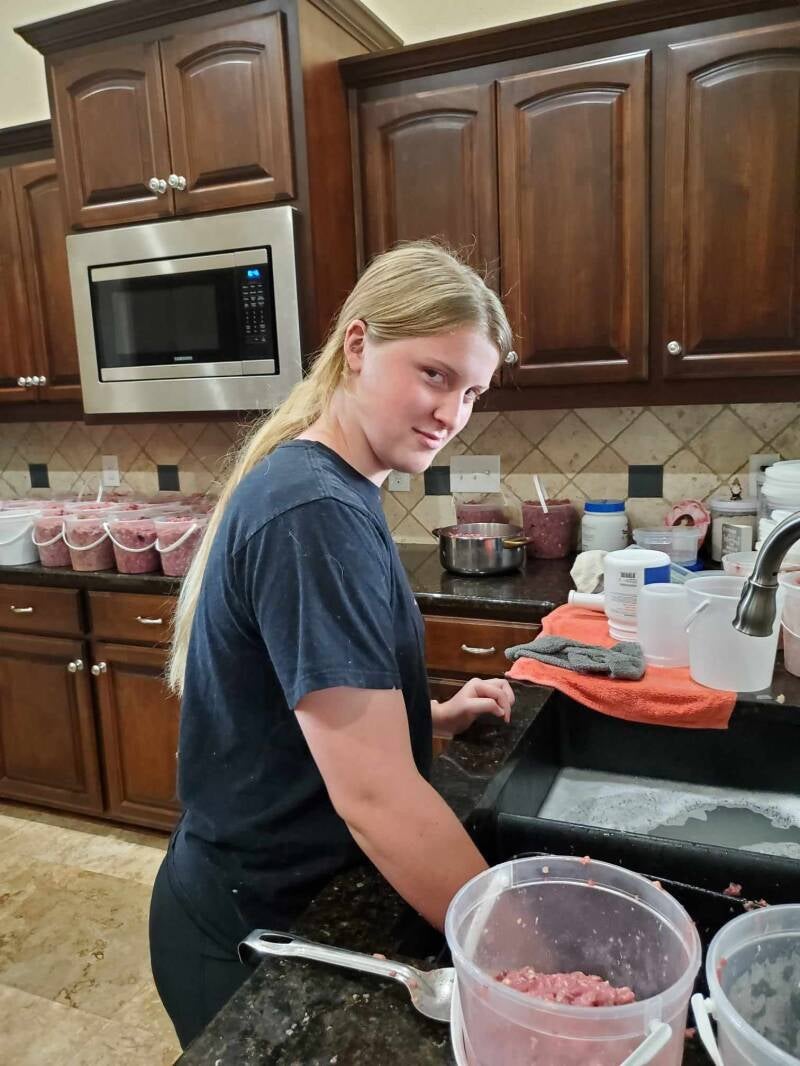

Step 5: Mix the containers of broth (Some are beef, some are chicken, and all vitamins for each group are mixed into this). This job takes some hands on work. We mix 10-15 lbs of ground meat with 5 lbs of ground heart, mix in 1 cup ground liver (my cats hate raw liver so we cook it and then grind it). Each bucket has Vitamin B, Taurine and sometimes added goodies like Benebac, raw egg yolks, or if we have URI going around we will add Lysine powder. Mixing is done by hand. Then scooped into 5lb buckets, wiped with warm wet washcloth and then sat on cupboard.
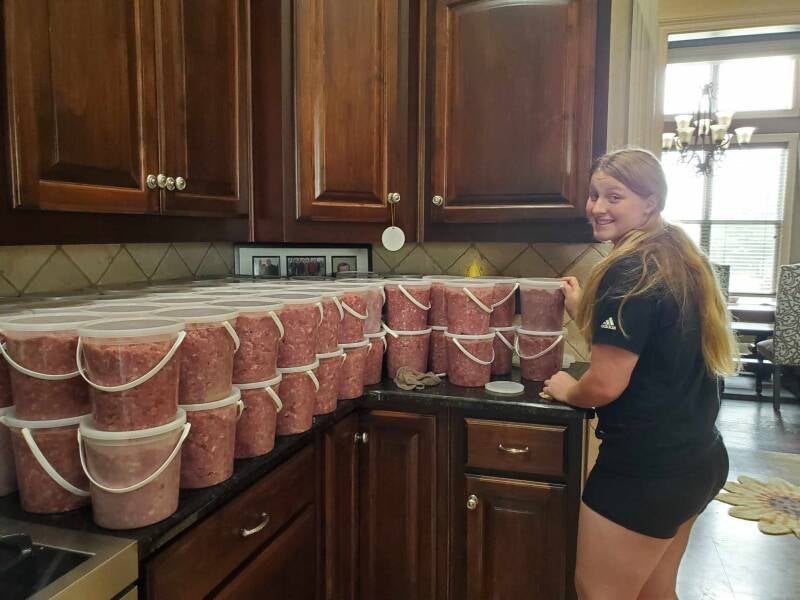
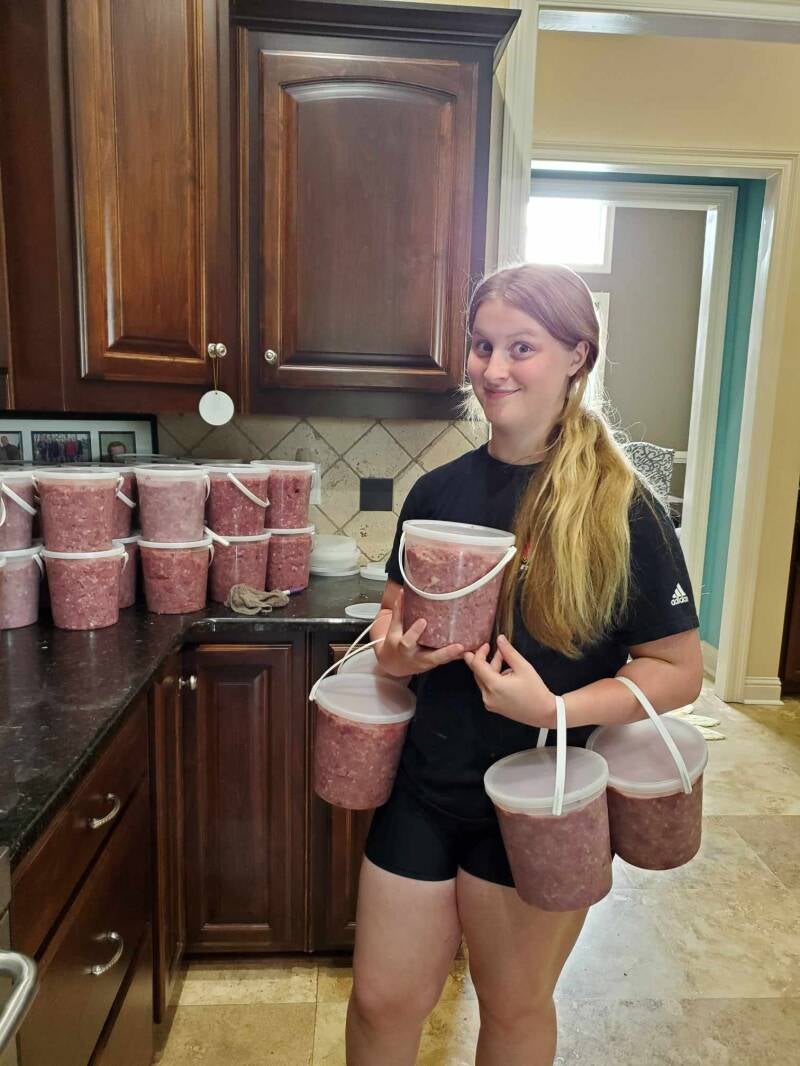
Step 6: Buckets are marked if they are 3rd ground (for babies) or if cooked meats are added to a batch. We use masking tape on lid of buckets. Then we carry them out and put in large freezer. We make a one month supply and freeze it. This is what it takes to feed a cattery. and Yes they love it. Sometimes we have a bucket of whole or ground heart extra, and we mark that also. Kitties love it when they get a treat of platefuls of heart for one meal, every so often. Sometimes we will sell a few buckets to people who buy our kitties. 5lb bucket, frozen for $35
